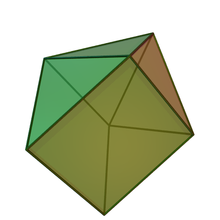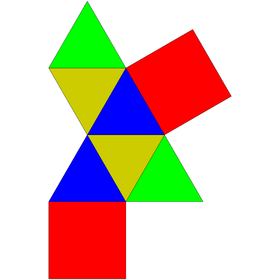Augmented triangular prism
| Augmented triangular prism | |
|---|---|
 | |
| Type | Johnson J48 – J49 – J50 |
| Faces | 6 triangles 2 squares |
| Edges | 13 |
| Vertices | 7 |
| Vertex configuration | |
| Symmetry group | |
| Properties | convex |
| Net | |
 | |
In geometry, the augmented triangular prism is a polyhedron constructed by attaching an equilateral square pyramid onto the square face of a triangular prism. As a result, it is an example of Johnson solid. It can be visualized as the chemical compound, known as capped trigonal prismatic molecular geometry.
Construction
The augmented triangular prism can be constructed from a triangular prism by attaching an equilateral square pyramid to one of its square faces, a process known as augmentation.[1] This square pyramid covers the square face of the prism, so the resulting polyhedron has 6 equilateral triangles and 2 squares as its faces.[2] A convex polyhedron in which all faces are regular is Johnson solid, and the augmented triangular prism is among them, enumerated as 49th Johnson solid .[3]
Properties
An augmented triangular prism with edge length has a surface area, calculated by adding six equilateral triangles and two squares' area:[2]
It has three-dimensional symmetry group of the cyclic group of order 4. Its dihedral angle can be calculated by adding the angle of an equilateral square pyramid and a regular triangular prism. The dihedral angle of an equilateral square pyramid between two adjacent triangular faces is , and that between a triangular face and its base is . The dihedral angle of a triangular prism between two adjacent square faces is the internal angle of an equilateral triangle , and that between square-to-triangle is . Therefore, the dihedral angle of the augmented triangular prism between square-to-triangle and triangle-to-triangle on the edge where both square pyramid and triangular prism are attached is, respectively:[4]
Application
In the geometry of chemical compounds, a polyhedron may commonly visualize an atom cluster surrounding a central atom. The capped trigonal prismatic molecular geometry describes clusters for which this polyhedron is an augmented triangular prism.[5] An example of such compound is the potassium heptafluorotantalate.[6]
See also
- Biaugmented triangular prism — the 50th Johnson solid, constructed by attaching a triangular prism with two equilateral square pyramids.
- Triaugmented triangular prism — the 51st Johnson solid, constructed by attaching a triangular prism with three equilateral square pyramids.
References
- ^ Rajwade, A. R. (2001). Convex Polyhedra with Regularity Conditions and Hilbert's Third Problem. Texts and Readings in Mathematics. Hindustan Book Agency. p. 84–89. doi:10.1007/978-93-86279-06-4. ISBN 978-93-86279-06-4.
- ^ a b c Berman, Martin (1971). "Regular-faced convex polyhedra". Journal of the Franklin Institute. 291 (5): 329–352. doi:10.1016/0016-0032(71)90071-8. MR 0290245.
- ^ Francis, Darryl (August 2013). "Johnson solids & their acronyms". Word Ways. 46 (3): 177.
- ^ Johnson, Norman W. (1966). "Convex polyhedra with regular faces". Canadian Journal of Mathematics. 18: 169–200. doi:10.4153/cjm-1966-021-8. MR 0185507. S2CID 122006114. Zbl 0132.14603.
- ^ Hoffmann, Roald; Beier, Barbara F.; Muetterties, Earl L.; Rossi, Angelo R. (1977). "Seven-coordination. A molecular orbital exploration of structure, stereochemistry, and reaction dynamics". Inorganic Chemistry. 16 (3): 511–522. doi:10.1021/ic50169a002.
- ^ Kaupp, Martin (2001). ""Non-VSEPR" Structures and Bonding in d(0) Systems". Angew Chem Int Ed Engl. 40 (1): 3534–3565. doi:10.1002/1521-3773(20011001)40:19<3534::AID-ANIE3534>3.0.CO;2-#. PMID 11592184.
External links
- Weisstein, Eric W. "Johnson Solid". MathWorld.
- Weisstein, Eric W. "Augmented triangular prism". MathWorld.
- v
- t
- e
- elongated triangular pyramid
- elongated square pyramid
- elongated pentagonal pyramid
- gyroelongated square pyramid
- gyroelongated pentagonal pyramid
- triangular bipyramid
- pentagonal bipyramid
- elongated triangular bipyramid
- elongated square bipyramid
- elongated pentagonal bipyramid
- gyroelongated square bipyramid
- elongated triangular cupola
- elongated square cupola
- elongated pentagonal cupola
- elongated pentagonal rotunda
- gyroelongated triangular cupola
- gyroelongated square cupola
- gyroelongated pentagonal cupola
- gyroelongated pentagonal rotunda
- gyrobifastigium
- triangular orthobicupola
- square orthobicupola
- square gyrobicupola
- pentagonal orthobicupola
- pentagonal gyrobicupola
- pentagonal orthocupolarotunda
- pentagonal gyrocupolarotunda
- pentagonal orthobirotunda
- elongated triangular orthobicupola
- elongated triangular gyrobicupola
- elongated square gyrobicupola
- elongated pentagonal orthobicupola
- elongated pentagonal gyrobicupola
- elongated pentagonal orthocupolarotunda
- elongated pentagonal gyrocupolarotunda
- elongated pentagonal orthobirotunda
- elongated pentagonal gyrobirotunda
- gyroelongated triangular bicupola
- gyroelongated square bicupola
- gyroelongated pentagonal bicupola
- gyroelongated pentagonal cupolarotunda
- gyroelongated pentagonal birotunda
- augmented truncated tetrahedron
- augmented truncated cube
- biaugmented truncated cube
- augmented truncated dodecahedron
- parabiaugmented truncated dodecahedron
- metabiaugmented truncated dodecahedron
- triaugmented truncated dodecahedron
- gyrate rhombicosidodecahedron
- parabigyrate rhombicosidodecahedron
- metabigyrate rhombicosidodecahedron
- trigyrate rhombicosidodecahedron
- diminished rhombicosidodecahedron
- paragyrate diminished rhombicosidodecahedron
- metagyrate diminished rhombicosidodecahedron
- bigyrate diminished rhombicosidodecahedron
- parabidiminished rhombicosidodecahedron
- metabidiminished rhombicosidodecahedron
- gyrate bidiminished rhombicosidodecahedron
- tridiminished rhombicosidodecahedron






















